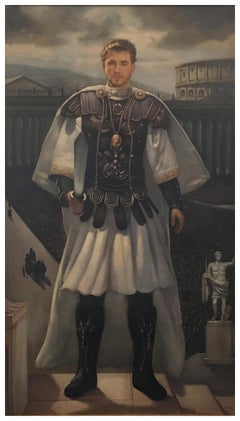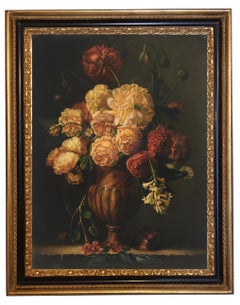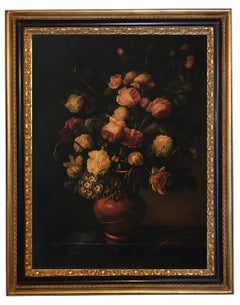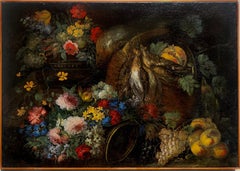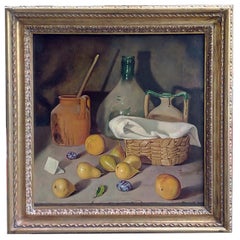Maximilian Ciccone Art
to
2
5
2
3
Overall Width
to
Overall Height
to
12
4
7
4
1
5
3
2
2
2
2
2
2
1
1
1
1
1
1
1
1
1
1
1
12
12
12
12
16
15
13
12
10
8
9
12
Artist: Maximilian Ciccone
Dealer: CAIAFA ARTE di MASSIMO CAIAFA
COMMODO - Italian School - Italia - Figurative - Oil on canvas painting
By Maximilian Ciccone
Located in Napoli, IT
Commodo - Maximilian Ciccone - Italia - Oil on canvas, portrait of Roman Emperor Commodo.Mis. cm. 210x120-
Category
Early 2000s Old Masters Maximilian Ciccone Art
Materials
Canvas, Oil
STILL LIFE OF FLOWERS AND FRUIT - Italian School - Oil on Canvas Italy Painting
By Maximilian Ciccone
Located in Napoli, IT
Still life of Flowers and Fruit - Maximilian Ciccone Italia 2002 - Oil on canvas cm.60x90.
This oil on canvas painting is an incredible example of the artist's ability to capture bre...
Category
Early 2000s Realist Maximilian Ciccone Art
Materials
Canvas, Oil
FLOWERS - In the Manner of Mario Dei Fiori - Oil On Canvas Italian Painting
By Maximilian Ciccone
Located in Napoli, IT
Flowers - Oil on canvas cm.80x60 by Maximilian Ciccone, Italy 2002.
In this oil on canvas painting the painter Ciccone draws inspiration from the masterpieces of the great Roman master Mario Nuzzi...
Category
Early 2000s Italian School Maximilian Ciccone Art
Materials
Canvas, Oil
FLOWERS -In the Manner of Mario Dei Fiori -Oil On Canvas Italian Painting
By Maximilian Ciccone
Located in Napoli, IT
Flowers - Oil on canvas cm.80x60 by Maximilian Ciccone, Italy 2002.
In this oil on canvas painting the painter Ciccone draws inspiration from the masterpieces of the great Roman master Mario Nuzzi...
Category
Early 2000s Italian School Maximilian Ciccone Art
Materials
Canvas, Oil
FLOWERS -In the Manner of Mario Dei Fiori -Oil On Canvas Italian Painting
By Maximilian Ciccone
Located in Napoli, IT
Flowers - Oil on canvas cm.80x60 by Maximilian Ciccone, Italy 2002.
Frame available on request from our workshop.
In this oil on canvas painting the painter Ciccone draws inspiration from the masterpieces of the great Roman master Mario Nuzzi...
Category
Early 2000s Old Masters Maximilian Ciccone Art
Materials
Canvas, Oil
STILL LIFE - Hyper - Realistic - Oil on Canvas Italian Painting
By Maximilian Ciccone
Located in Napoli, IT
Stil life Maximilian Ciccone Italia 2011 Oil on canvas mis. cm. 60x90.
This oil on canvas painting is an incredible example of the artist's ability to capture breathtaking detail a...
Category
2010s Realist Maximilian Ciccone Art
Materials
Canvas, Oil
GENGHIS KHAN - Italian School - Oil on Canvas Italian Figurative Painting
By Maximilian Ciccone
Located in Napoli, IT
GENGIS KAN - Maximilian Ciccone - Italia - Oil on canvas cm.210x120.
In this majestic oil on canvas painting the Artist Ciccone portray the Mongol leader and ruler Genghis Khan...
Category
2010s Old Masters Maximilian Ciccone Art
Materials
Canvas, Oil
LEMON, GRAPE AND PUMPKIN- Hyperrealism Italian still life oil on canvas painting
By Maximilian Ciccone
Located in Napoli, IT
LEMON, GRAPE AND PIMPKIN - Oil on canvas by Maximilian Ciccone, Italy 2011.
Frame available on request from our workshop.
This oil on canvas painting is an incredible example of the...
Category
21st Century and Contemporary Realist Maximilian Ciccone Art
Materials
Canvas, Oil
Basket With Fruit - Hyperrealism - Oil On Canvas Italian Still Life Painting
By Maximilian Ciccone
Located in Napoli, IT
Basket with fruit - Maximilian Ciccone Italia 2011 - Oil on canvas cm.40x50.
This oil on canvas painting is an incredible example of the artist's ability to capture breathtaking deta...
Category
2010s Realist Maximilian Ciccone Art
Materials
Canvas, Oil
SAMURAI -Italian School - Oil on Canvas Italian Figurative Painting
By Maximilian Ciccone
Located in Napoli, IT
Samurai - Maximilian Ciccone - Italia - Oil on canvas cm.210x120-
In this majestic oil on canvas painting the Artist Ciccone portrays a samurai, exhibiting the Japanese warrior cast...
Category
2010s Old Masters Maximilian Ciccone Art
Materials
Canvas, Oil
STILL LIFE - Neapolitan School - Oil On Canvas Italian Painting
By Maximilian Ciccone
Located in Napoli, IT
STILL LIFE - Oil on canvas cm.80x60 by Maximilian Ciccone, Italy 2002.
in this oil on canvas painting the painter Ciccone draws inspiration from the painting of the Neapolitan school...
Category
Early 2000s Italian School Maximilian Ciccone Art
Materials
Canvas, Oil
THE LENS AND THE GRAPES- Hyper- Realistic- Still Life Oil on Canvas Painting
By Maximilian Ciccone
Located in Napoli, IT
The lens and the grapes Maximilian Ciccone Italia 2002 Oil on canvas mis. cm. 80x80
This oil on canvas painting is an incredible example of the artist's ability to capture breathtaki...
Category
Early 2000s Realist Maximilian Ciccone Art
Materials
Canvas, Oil
Related Items
17th century Italian still-life with flowers, fruits and game
Located in Aartselaar, BE
This opulent 17th-century Italian still-life captures the abundance and refinement of the Baroque era, presenting a feast for the senses. The composition features an array of ripe, s...
Category
17th Century Old Masters Maximilian Ciccone Art
Materials
Canvas, Oil
Pocket Gooseberry (Hairy) 2, Orig. Oil Painting, Still Life, Gooseberry, Frui
By Dani Humberstone
Located in Deddington, GB
Pocket Green Gooseberry (Hairy) 2 is an original oil painting by Dani Humberstone as part of her Pocket Painting series featuring small scale realistic oil paintings, with a nod to b...
Category
2010s Realist Maximilian Ciccone Art
Materials
Canvas, Oil
H 5.91 in W 5.91 in D 0.99 in
Pocket Lemon 2022, Original Painting, Still Life, Fruit Art
By Dani Humberstone
Located in Deddington, GB
Pocket Very Yellow Lemon is an original oil painting by Dani Humberstone as part of her Pocket Painting series featuring small scale realistic oil paintings, with a nod to baroque st...
Category
2010s Realist Maximilian Ciccone Art
Materials
Canvas, Oil
H 6.11 in W 6.11 in D 1.19 in
Florals in classic urn Old Masters 17th century Dutch style
Located in Hillsborough, NC
Floral with Urn is in a classical Dutch style that dates to the 17th century. The bright flowers drape the urn in whites, crimsons and pinks, standing out against the darker foliage...
Category
17th Century Old Masters Maximilian Ciccone Art
Materials
Canvas, Oil
Pocket Pink Rose with Leaf 2, Original Painting, Still Life, Flower Art, Floral
By Dani Humberstone
Located in Deddington, GB
Pocket Pink Rose with Leaf 2 is an original oil painting by Dani Humberstone as part of her Pocket Painting series featuring small scale realistic oil...
Category
2010s Realist Maximilian Ciccone Art
Materials
Canvas, Oil
H 5.91 in W 5.91 in D 1.19 in
17th Century Italian Old Master Oil Painting Moses Striking Water from the Rock
By Pier (Pietro) Dandini
Located in Cirencester, Gloucestershire
Moses Striking Water from the Rock;
Circle of Pietro Dandini, Italian 1646-1712
Italian School, late 17th century
oil on canvas, framed
framed: 3...
Category
Early 18th Century Old Masters Maximilian Ciccone Art
Materials
Canvas, Oil
Diptych of Pocket Yellowy Orange Clementine and Very Shiny Very Red Apple
By Dani Humberstone
Located in Deddington, GB
Very Shiny Very Red Apple is an original oil painting by Dani Humberstone as part of her series of realistic oil paintings of fruit with a nod to baroque still life painting. The pa...
Category
2010s Realist Maximilian Ciccone Art
Materials
Canvas, Oil
H 5.91 in W 11.82 in D 0.99 in
Wildlife Collection: Pocket Goldfinch, Original Painting, Animal Art
By Dani Humberstone
Located in Deddington, GB
Wildlife Collection: Pocket Goldfinch is an original oil painting by Dani Humberstone as part of her Pocket Painting series featuring small scale realistic oil paintings, with a nod ...
Category
2010s Realist Maximilian Ciccone Art
Materials
Canvas, Oil
H 5.91 in W 5.91 in D 1.19 in
King Charles 1st Antique Oil Painting Portrait of Famous British Monarch
Located in Cirencester, Gloucestershire
King Charles I
British artist, early 20th century
signed with initials
oil on canvas, framed
framed: 36 x 29 inches
canvas: 32 x 26 inches
provenance: p...
Category
Early 1900s Old Masters Maximilian Ciccone Art
Materials
Oil, Canvas
Cherries in a Saucer- original realism still life oil painting- contemporary art
Located in London, Chelsea
This elegantly framed artwork is currently on display and available for sale at Signet Contemporary Art Gallery and online.
A vision of delicacy and refinement, Cherries in a Saucer...
Category
21st Century and Contemporary Realist Maximilian Ciccone Art
Materials
Canvas, Oil
Large Antique Italian Baroque 18th Century Still Life Fruit Oil Canvas Painting
Located in Portland, OR
An exceptional & large antique Italian baroque still life oil on canvas painting, attributed to Carlo Magini (1720-1804), a still life scene of a table setting with bowls of fruit, c...
Category
1780s Italian School Maximilian Ciccone Art
Materials
Oil, Canvas
Still Life of Wine, Onion and Carrots
By Jack Lynn
Located in Soquel, CA
Beautiful still life painting of a table consisting of wine, onions and carrots by California plein air artist Jack Lynn. Unsigned. Unfram...
Category
1980s American Impressionist Maximilian Ciccone Art
Materials
Canvas, Oil
Previously Available Items
STILL LIFE - Hyper - Realistic -Italian Oil on Canvas Painting
By Maximilian Ciccone
Located in Napoli, IT
Still life Maximilian Ciccone Italia 2002 Oil on canvas cm. 55x55.
Gold leaf gilded wooden frame available on request.
This oil on canvas painting is an incredible example of the ar...
Category
Early 2000s Old Masters Maximilian Ciccone Art
Materials
Canvas, Oil
BASKET OF FRUIT - Hyperrealism - Italian still life oil on canvas painting,
By Maximilian Ciccone
Located in Napoli, IT
BASKET WITH FRUIT - Oil on canvas cm.50x40 by Maximilian Ciccone, Italy 2011.
Frame available on request from our workshop.
This oil on canvas painting is an incredible example of t...
Category
21st Century and Contemporary Realist Maximilian Ciccone Art
Materials
Canvas, Oil
FLOWERS - In the Manner of Mario Dei Fiori -Italian Oil on Canvas Painting
By Maximilian Ciccone
Located in Napoli, IT
FLOWERS - Oil on canvas cm.80x60 by Maximilian Ciccone, Italy 2002
Frame available on request from our workshop.
in this oil on canvas painting the painter Ciccone draws inspiration...
Category
21st Century and Contemporary Old Masters Maximilian Ciccone Art
Materials
Canvas, Oil
EMBRACE OF FRUIT - Italian still life oil on canvas painting, Maximilian Ciccone
By Maximilian Ciccone
Located in Napoli, IT
EMBRACE OF FRUIT - Oil on canvas cm.30x80 by Maximilian Ciccone, Italy, 2011
Frame available on request from our workshop.
Category
2010s Old Masters Maximilian Ciccone Art
Materials
Canvas, Oil
HOLY SCENE
By Maximilian Ciccone
Located in Napoli, IT
Holi scene - Maximilian Ciccone Italia 2011 - Oil on copper cm.50x50. Gold leaf gilded wooden frame.
Category
2010s Old Masters Maximilian Ciccone Art
Materials
Copper
Maximilian Ciccone art for sale on 1stDibs.
Find a wide variety of authentic Maximilian Ciccone art available for sale on 1stDibs. You can also browse by medium to find art by Maximilian Ciccone in canvas, fabric, oil paint and more. Much of the original work by this artist or collective was created during the 21st century and contemporary and is mostly associated with the Old Masters style. Not every interior allows for large Maximilian Ciccone art, so small editions measuring 20 inches across are available. Customers who are interested in this artist might also find the work of Francesca Strino, Gianluca Corona, and Kelly Birkenruth. Maximilian Ciccone art prices can differ depending upon medium, time period and other attributes. On 1stDibs, the price for these items starts at $1,647 and tops out at $3,843, while the average work can sell for $2,306.
